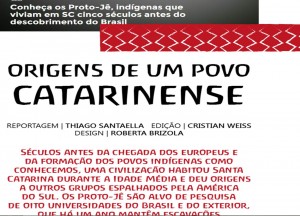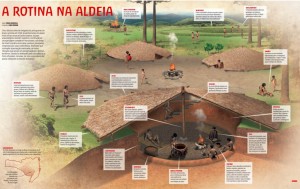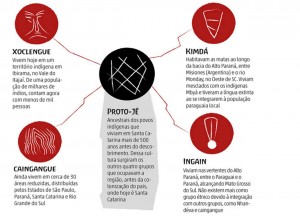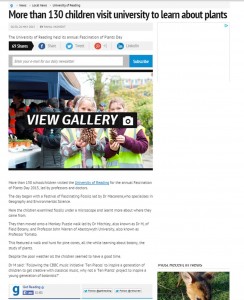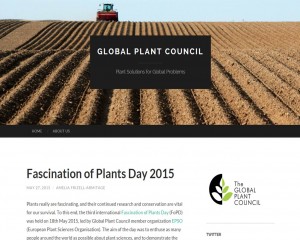Jê Landscapes at International Palynology and Palaeobotany Congress XIV IPC X IOPC
The Jê project made two presentations at the International Congress of Palynology. These were:
‘Pre-Columbian human land use versus climate change: understanding Araucaria forest expansion during the Late Holocene in southern Brazil’
AUTHORS: Macarena L. Cárdenas, Francis E. Mayle, Jose Iriarte, Jonas Gregorio de Souza,Priscilla Ulguim, Mark Robinson, Rafael Corteletti, Paulo DeBlasis
and
‘Characterisation of the modern pollen rain-vegetation relationship of Araucaria forest of southern Brazil by analysis of moss polsters’
AUTHORS: Macarena L. Cárdenas, Francis E. Mayle, Lauri A. Schorn, Jose Iriarte
Both presentations were well received by the research community.

Macarena Cardenas presenting at the Conference
For more details of the presentations and the conference, including photos, click here.
Talking Anthropology, Climate and Weather Conference
Four fantastic talks from our team members in the UK will be given at this weekend’s Conference “Anthropology, Climate and Weather Conference” at the British Museum at our session:
The talks will include palaeoecological and archaeological findings and the meaning for human and climate:
- Francis Mayle, Ruth Dickau, Bronwen Whitney, Jose Iriarte. Pre-Columbian raised-field agriculture in Amazonian Bolivia — What lessons for sustainable land use today?
- Macarena Cárdenas, Francis Mayle, Jose Iriarte, Lauri Schorn. Dynamics of the Brazilian Araucaria forest and its responses to human land use and climate change, a long term perspective
- Jonas Gregorio de Souza, Jose Iriarte, Richard Jones, Francis Mayle. Out of Amazonia: Late Holocene Climate Change and the Tupi-Guarani Trans-Continental Expansion
- Jonas Gregorio de Souza, Mark Robinson. The making of the forest: past human impact on species distribution in the southern Brazilian highlands
If you are around, come to see us!
Click here for more details
By Macarena
Origins of a culture in Santa Catarina
As it is being discovered, Je Landscapes project has published in DC newspaper of Santa Catarina, Brazil, the story of the early starts and development of the Je culture. Click here to access.
Check out the great info-graphics and video in this report. (available in Portuguese).
Studying Jê sediments 2: A&E
This is the second round about the latest analysis we have been doing to the sediments for the palaeoecological research within our project:
This time the analysis sent us directly to hospital!!. Click here to find more about how we are using a gun to reveal the past.
Studying Jê sediments with a gun
Discover the latest analysis we have been doing to the sediments for the palaeoecological research within our project:
Our quest for understanding the past land use within Jê landscapes pushes us to find ways to extract the information in what is sometimes quite an exotic manner. Click here to find more about how we are using a gun to reveal the past.
Palaeoecology
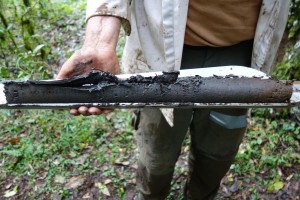
What is it?
Palaeoecology is the study of microscopic remains of organisms (e.g. fossil pollen and charcoal) from lake and bog sediments to reconstruct the long-term, millennial-scale, history of ecosystems, in the context of natural (e.g. climate) and anthropogenic disturbance.
How does it work?
In our Je project we analyse pollen as a proxy for vegetation and charcoal as a proxy for fire. Plants produce vast quantities of pollen which enter into basins such as lakes or bogs, either by aerial input or via inflowing streams, where they are well preserved for millennia due to the oxygen-poor and/or acidic conditions of the site. Sediment cores are retrieved using a manual coring device (e.g. piston or ‘Russian’ corer), shipped back to the lab, sub-sampled, and treated with a variety of chemicals and strong acids to concentrate the pollen. Pollen residues are mounted onto microscope slides and typically viewed at x 400 magnification. Fossil pollen can be identified to genus or family level, according to their distinctive shapes and surface patterning, by comparison with modern reference material. The relative proportions of different pollen types reflect the relative abundance of the constituent plant genera and families that comprise the ‘parent’ vegetation of the surrounding catchment. Pollen from small bogs or lakes typically reflect local vegetation, while pollen from large lakes reflect regional vegetation across a larger geographic scale. By analysing pollen assemblages from a series of samples down-core, we can compile a history of vegetation change through time. A chronology of millennial-scale vegetation change is obtained by radiocarbon dating – either the organic ‘bulk’ sediment or terrestrial plant macrofossils such as seeds or twig fragments.
Charcoal can also be concentrated from the same lake/bog sediments. Changes in abundance of charcoal particles through the core reflect changes in fire activity through time, with large particles generally signifying burning close to the bog or lake and smaller microscopic particles signifying burning further away across a broader regional scale.
Our reconstructions of past environmental change can be further enhanced by use of other complementary techniques:
Phytoliths are microscopic silica bodies which are diagnostic of different plant taxa, but unlike pollen, are well preserved, not only in lake and bog sediments, but also soils. The combination of pollen- and phytolith-based analyses allows for more detailed vegetation reconstructions than either proxy alone. Phytoliths are especially useful for differentiating different kinds of grass (e.g. aquatic versus terrestrial) in the palaeoenvironmental record.
Stable carbon isotopes can provide further insights into past vegetation change, especially open, herb-dominated landscapes versus forest, while X-ray fluorescence and magnetic susceptibility techniques can provide information on catchment erosion.
Jê landscapes and Palaeoecology: human-environment interactions
A central aim of our Je project is to closely integrate palaeoecology with archaeology to better understand the relationship between the Je culture and their environment. To achieve this, we are selecting palaeoecological sites (bogs) which are sufficiently close to archaeological sites to effectively integrate these complementary lines of evidence (Mayle & Iriarte, 2014).
Our palaeoecological approach will address the following themes:
Agriculture – What crops were cultivated and did the staple crop (e.g. maize versus cassava) change through time or space; e.g. depending on climate, soil, ecosystem?
Fire – How important was fire as a land-management tool?
Expansion of Araucaria (monkey-puzzle) trees – Previous pollen studies across the southern highlands of Brazil (e.g. Iriarte and Behling 2007) have shown a consistent pattern of late Holocene expansion of Araucaria forest, which correlates with independent evidence for progressively wetter climatic conditions (e.g. oxygen isotope evidence from the Botuvera speleothem, Cruz et al. 2005), suggestive of a climatic driver for this forest expansion. Closer inspection reveals that the timing of this forest expansion also correlates closely with the proliferation of Je sites ca. 2,000 yr BP. Given the recognised economic importance of this tree to the Je culture – in terms of food, currency, and even as a signal of power (refs?) – an alternative hypothesis is that Araucaria expansion was promoted by the Je culture. Our integrative approach should help resolve the respective roles of people versus climate in driving this important vegetation change.
References
Cruz, Jr., F.W. et al. 2005. Insolation-driven changes in atmospheric circulation over the past 116,000 years in sub-tropical Brazil. Nature 434, 63-66.
Iriarte, J. and H. Behling. 2007. The expansion of Araucaria forest in the southern Brazilian highlands during the last 4000 years and its implications for the development of the Taquara/Itararé Tradition. Environmental Archaeology 12, 115-127.
Mayle, F.E. and Iriarte, J. 2014. Integrated Palaeoecology and Archaeology – A powerful approach for understanding Pre-Columbian Amazonia. Journal of Archaeological Science 51, 54-64.
Anthropology, Weather & Climate Change Conference
27-29 May 2016
Organized by Royal Anthropological Institute
Were will be holding the panel (P31): Indigenous populations-vegetation-climate relationship in the past: what can this teach us about sustainable vegetation use in the present?
If you are interested in participating please read more for info
Araucaria is fascinating to all
The Palaeoecology team led by Dr Macarena Cárdenas recently hosted an event at the University of Reading (UoR), the Fascination of Plant Day, were the Araucaria tree (Monkey Puzzle) was the main actor.
Vice-chancelor from UoR, academics, students and over 130 kids from schools came along to get fascinated by the story of Araucaria tree and its relation with human.
Click in the images to see media coverage:
Jê Landscapes of Southern Brazil | Privacy Policy


